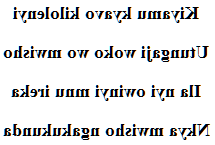Chagga love poem
Kilola
Kiyamu kyavo kilolenyi
Utungaji woko wo mwisho
Ila nyi owinyi mnu ireka
Nkya mwisho ngakukunda


→ French poem ←
Chaga language
Somebody told me the she was Chagga. So i have asked to get this translation of my love poem into Chaga (Various names: Central Chaga, Mochi, Central Kilimanjaro, kichagga, Old Moshi, Chagga, Kimochi, Moshi, Kimoshi, Mosi, Uru).
Chaga, is actually a collection of Bantu languages, which are quite diverse, and can be classified into several groups, spoken in Tanzania and Kenya by around 700,000 people.
The translation referred on this page is in Central Chaga, and its speakers live in the Moshi District. We can subdivide the language they speak into several dialects .... I have put some names above.
The other two major groups of the chaga dialects are: the western chaga, spoken in the district of Hai, and the eastern chaga, spoken in the district of Mwanga ... themselves grouping together different dialects.
Chaga, is how they call themselves, and the name that was retained during colonization, to designate their ethnic group and their language.
They live on the slopes of Kilimanjaro, and for others, who speak quite different idioms, in the north of the Pare Mountains.
If the geographical location of their villages, with the presence of the mountain, could have suggested more linguistic diversity inside the chaga group, it should be noted in any case that it is difficult to relate chaga languages to others neighboring Bantu languages ... Have they been not a lot in contact with their Bantu neighbors, and conversely more in contact with their non-Bantu neighbors?
It seems in any case that in their many moves, they met other groups already present, adapting their language.
They could also be often hostile to each other, and therefore, try to have no many contact between them. The conflicts may have been so violent that some people had to flee and move to save their lives.
Today it should also be noted that the number of Chaggas who use their mother tongue is decreasing, and this is necessarily worrying.
The Chagas
In the kilimanjaro region, we find traces of fire, lit by men 3,000 years ago, without being able to say whether they are the work of hunter-gatherers or nomadic pastoralists.
The first terracotta objects found date back to 2,000 years ago, and may suggest that they were the work of Bantu groups, so perhaps Chagas.
The Chaggas (Wachagga or Dschagga), probably originate from the gathering of different Bantu groups, who came to settle, first in the north of the Pare mountains (their historical cradle), then around Mount Kilimanjaro, which was not only the mountain we know, but also a very dense forest.
This melting pot of various groups, used ingenious terraced irrigation systems, which sometimes earned them the nickname "Asians of Africa". They mainly cultivated cotton, Arabica coffee, bananas and cereals.
Their culture is rich in traditional musical instruments, drums and flutes, that they shape with art. They use them in joyous festivals enlivened by dances. Their oral traditions made up of legends are rich and varied.
West kilimanjaro poem